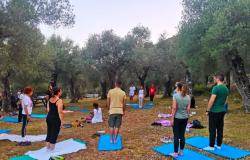The online marketplace is flooded with retailers selling solar eclipse glasses who claim to have the NASA seal of approval. Consider that a red flag to look elsewhere.
Solar eclipse 2024: What to know, how to prepare
AccuWeather astronomy expert Brian Lada goes over the key things to know about the upcoming total solar eclipse that will darken the skies over the United States from Texas to Maine on April 8.
In the lead-up to the highly anticipated total solar eclipse, the online marketplace had been flooded with manufacturers claiming to be selling protective eyewear approved by NASA.
The seal of approval from one of the world’s leading space agencies sounds prestigious, doesn’t it?
It should also be a surefire sign for you to avoid that particular product if possible.
Not because the US space agency isn’t reputable or knowledgeable when it comes to all things cosmic. But rather because NASA is just not in the business of endorsing any sort of merchandise.
So if you come across solar eclipse glasses claiming to be “NASA-backed,” tread carefully. As a NASA spokeswoman told USA TODAY: ‘We are simply not a certification agency.’
When is the 2024 total solar eclipse? Your guide to glasses, forecast, where to watch.
NASA does not endorse any eclipse products
In the rush to acquire some coveted eclipse glasses before April 8, it may be easy to fall victim to the fakes and imitators proliferating online retailers.
While plenty of legitimate certified eyewear is widely available, less-scrupulous manufacturers may try all sorts of methods and tricks to get your attention and make you believe the product you’re about to buy is the real deal. And what could be more trustworthy than a product emblazoned with NASA’s name or logo?
Pretty much anything else, it turns out.
NASA of course highly recommends that skygazers get a pair of certified eclipse glasses before the total solar eclipse charts a 115-mile-wide path of totality blanketing much of North America in uncharacteristic darkness. But the US Space agency itself does not approve any particular brand of solar viewers, despite what many vendors may claim.
And though the agency has distributed eclipse glasses with its logo at its events for free, those items have never been for sale, the agency told USA TODAY.
Where to get certified solar eclipse glasses
The responsibility of guiding American consumers to the safest eclipse glasses is largely left to the American Astronomical Society.
The organization maintains a curated list of approved vendors of solar eclipse glasses and its been updated to give priority to North American manufacturers for the upcoming astral event. What you can bank on if you buy from a manufacturer included on the list is that your purchased product is in compliance with the highest international safety standards.
That agency, the International Organization for Standardization, only vouchers for solar eclipse glasses that are dark and strong enough to filter out a certain amount of the sun’s harmful light.
The astronomical society also provides some helpful tips for how to spot counterfeit glasses.
Compared to regular sunglasses, proper eclipse glasses are 100,000 times darker to block nearly all visible, infrared and ultraviolet light and protect our sensitive retinas when looking skyward.
Reputable vendors can be found on any eclipse websites like GreatAmericanEclipse.com and NationalEclipse.com, which sell a variety of eyewear products, along with plenty of other gadgets one may need to see the eclipse. Additionally, American Paper Optics, the nation’s largest supplier of eclipse glasses, offers express shipping and includes a countdown at the top of its website to let you know the deadline to make a purchase to get your glasses in time for the big day.
What else to know about the total solar eclipse
What makes a total eclipse unique compared to partial solar eclipses is that the millions of people who witness it in the United States will have an opportunity to safely gaze upon the sight with the naked eye.
But until that moment, spectators will need proper eyewear just like they would for any other eclipse, according to NASA.
You’ll know it’s safe to fully take in the dazzling display when the moon – which is close enough in its orbit of Earth to appear as large as the sun – blocks the sun’s face and the sky darkens. That’s when “totality” occurs, whereby observers can see the outermost layer of the sun’s atmosphere known as the corona.
Hundreds of cities in 13 states are on the path of totality for this year’s total solar eclipse, which will pass from southwest to northeast across North America. You won’t want to miss it, as this is the last such eclipse in North American until 2044.
And as you make your eclipse-viewing plans, these interactive maps should help you chart the time and duration for when totality would occur in cities along the path.
Eric Lagatta covers breaking and trending news for USA TODAY. Reach him at [email protected]






